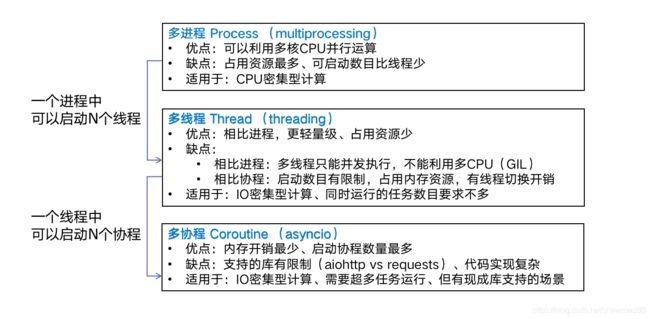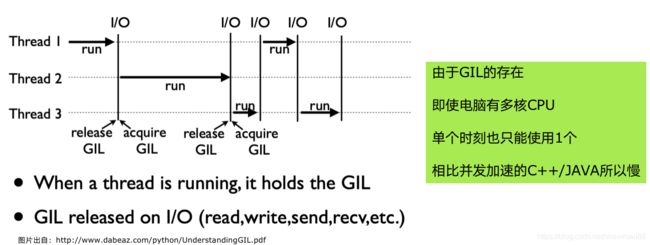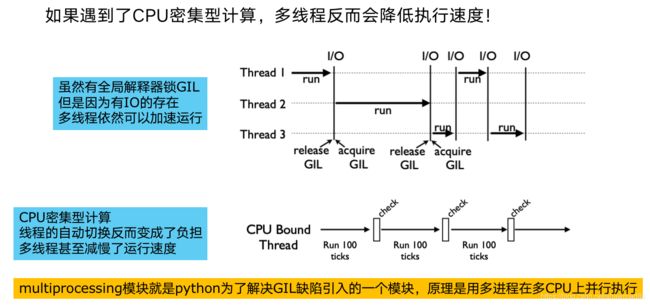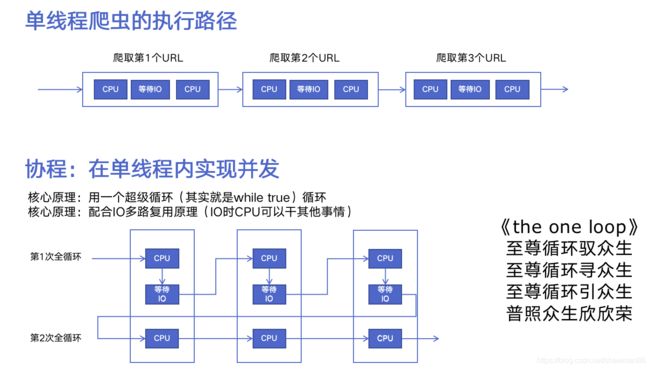python并发编程手册
文章目录
- 并发编程介绍
-
- python中的并发编程
- CPU密集型计算和IO密集型计算
- 多线程,多进程,多协程的对比
- 怎样根据任务选择对应技术
- 全局解释器锁GIL
- 多线程
-
- 简单流程
- 简单的一个多线程爬虫
- 生产者消费者模式进行多线程爬虫
- 线程安全概念
- 线程锁使用实例
- 线程池概念介绍
- 线程池的使用方法
-
- 使用线程池实现多线程爬虫
- 使用线程池在flask-web服务中加速
- 多进程
-
- 多进程multiprocessing知识梳理
- 多线程的实现
- 使用多进程在flask-web服务中加速
- 协程
-
- 协程内容的介绍
- python异步IO库介绍: asyncio
- 协程爬虫实现
- 信号量
- 使用信号量控制协程数进行爬虫
并发编程介绍
python中的并发编程

- 第一列为单线程串行,即CPU和IO是串起来执行的。IO的速度会严重制约CPU的运算速度
- 第二列为多线程并发,即当前线程遇到IO,释放CPU,可以提高CPU的运行效率
- 第三列为多进程并行,即使用的是多个CPU,然后进行计算
- 第四列为多机器并行,即使的的是多个机器同时计算同一个任务。
并行支持一下几种:
- 多线程:threading,利用CPU和IO可以同时执行的原理,让CPU不会干巴巴等待IO完成
- 多进程:multiprocessing,利用多核CPU的能力,真正的并行执行任务
- 异步IO:asyncio,在单线程利用CPU和IO同时执行的原理,实现函数异步执行
线程通信主要有:
- 使用Lock对资源加锁,防止冲突访问
- 使用Queue实现不同线程/进程之间的数据通信,实现生产者-消费者模式
- 使用线程池Pool/进程池Pool,简化线程/进程的任务提交、等待结束、获取结果
- 使用subprocess启动外部程序的进程,并进行输入输出交互
CPU密集型计算和IO密集型计算
CPU密集型(CPU-bound): CPU密集型也叫计算密集型,是指I/O在很短的时间就可以完成,CPU需要大量的计算和处理,特点是CPU占用率相当高。例如:压缩解压缩、加密解密、正则表达式搜索
IO密集型(I/O-bound):
IO密集型指的是系统运作大部分的状况是CPU在等I/O (硬盘/内存) 的读/写操作,CPU占用率仍然较低。例如:文件处理程序、网络爬虫程序、读写数据库程序
多线程,多进程,多协程的对比
python并发编程有三种方式: 多线程Thread、多进程Process、多协程Coroutine。

怎样根据任务选择对应技术
如果是CPU密集型计算,使用多进程multiprocessing
如果是IO密集型计算,则考虑多线程或者多线程。如果任务量大,有现成协程库支持,协程实现的复杂度可接受则首选协程,否则选线程。
全局解释器锁GIL
全局解释器锁(英语:Global Interpreter Lock,缩写GIL)是计算机程序设计语言解释器用于同步线程的一种机制,它使得任何时刻仅有一个线程在执行。即便在多核心处理器上,使用 GIL 的解释器也只允许同一时间执行一个线程。

虽然上图启动了三个线程,但是同一时刻,只有一个线程在执行,首先线程1拿到GIL然后执行,当前需要I/O时,则释放GIL,然后线程2拿到GIL, 执行,就这样,谁拿到GIL,谁就执行,否则,就阻塞。
为什么要有GIL?
为了解决多线程之间数据完整性和状态同步问题。
举例子:Python中对象的管理,是使用引用计数器进行的,引用数为0则释放对象。开始:线程A和线程B都引用了对象obj,obj.ref_num = 2,线程A和B都想撤销对obj的引用

上图中线程A和线程B都引用了对象obj, 首先,线程A准备销毁obj引用,将计数器减1,刚减完,切换到了线程B, 线程B也要销毁obj引用,将计数器减1,然后判断引用等于0,则将其释放掉。 当切换到线程A继续执行的时候,发现obj的引用已经无法获取计数器的值了。 所以,就报错了。
怎样规避GIL带来的限制?
1、多线程 threading 机制依然是有用的,用于IO密集型计算。因为在 I/O (read,write,send,recv,etc.)期间,线程会释放GIL,实现CPU和IO的并行。因此多线程用于IO密集型计算依然可以大幅提升速度。但是多线程用于CPU密集型计算时,只会更加拖慢速度
2、使用multiprocessing的多进程机制实现并行计算、利用多核CPU优势。为了应对GIL的问题,Python提供了multiprocessing
多线程
简单流程
- 准备一个函数
def my_func(a, b): do_craw(a,b) - 创建一个线程
import threading t = threading.Thread(target=my_func, args=(100, 200) - 启动线程和等待结束
t.start() # 启动线程 t.join() # 等待结束
简单的一个多线程爬虫
"""
@file : 001-多线程.py
@author : xiaolu
@email : luxiaonlp@163.com
@time : 2021-02-01
"""
import threading
import time
import requests
def craw(url):
# 这是个爬虫
r = requests.get(url)
print(url, r.status_code)
def single_thread():
# 单线程爬虫
print('single_thread start')
for url in urls:
craw(url)
print('single_thread end')
def multi_thread():
# 多线程爬虫
print("multi_thread begin")
threads = []
for url in urls:
threads.append(
threading.Thread(target=craw, args=(url,)) # url, 之所以加逗号 是因为这里必须为元组
)
# 启动多线程
for thread in threads:
thread.start()
# 等待结束
for thread in threads:
thread.join()
print("multi_thread end")
if __name__ == '__main__':
# 爬50页的内容
urls = ['https://www.cnblogs.com/sitehome/p/{}'.format(page) for page in range(1, 50 + 1)]
# 单线程走起
start = time.time()
single_thread()
end = time.time()
print("single thread cost:", end - start, "seconds")
# 多线程走起
start = time.time()
multi_thread()
end = time.time()
print("multi thread cost:", end - start, "seconds")
生产者消费者模式进行多线程爬虫

在实现生产者消费者模式之前,了解一下多线程数据通信queue。queue.Queue可以用于多线程之间的,线程安全的数据通信。
# 1. 带入类库
import queue
# 2. 创建Queue
q = queue.Queue()
# 3. 添加元素
q.put(item)
# 4. 获取元素
item = q.get()
# 5. 查询状态
q.qsize() # 查看当前元素的个数
q.empty() # 判断是否为空
q.full() # 判断是否已满
生产者消费者模式爬虫
"""
@file : 002-生产者消费者实现多线程爬虫.py
@author : xiaolu
@email : luxiaonlp@163.com
@time : 2021-02-01
"""
import queue
import time
import random
import threading
import requests
from bs4 import BeautifulSoup
def craw(url):
# 爬取网页内容
r = requests.get(url)
return r.text
def parse(html):
# 解析其中的内容
soup = BeautifulSoup(html, "html.parser")
links = soup.find_all("a", class_="post-item-title")
return [(link["href"], link.get_text()) for link in links] # 那链接和标题拿出来
def do_craw(url_queue: queue.Queue, html_queue: queue.Queue):
'''
生产者
:param url_queue: url的队列 生产者从中拿出链接 去爬虫
:param html_queue: 生产者将爬取的内容放到这里
:return:
'''
while True:
url = url_queue.get()
html = craw(url)
html_queue.put(html)
print('线程名: ', threading.current_thread().name,
"url_queue.size=", url_queue.qsize()) # 获取url队列中还有多少待爬取的
time.sleep(random.randint(1, 2))
def do_parse(html_queue: queue.Queue, fout):
'''
消费者
:param html_queue: 生产者生产出的内容
:param fout: 消费者将内容解析出来 存到fout中
:return:
'''
while True:
html = html_queue.get()
results = parse(html)
for result in results:
fout.write(str(result) + "\n")
print('线程名: ', threading.current_thread().name,
"html_queue.size=", html_queue.qsize())
time.sleep(random.randint(1, 2))
if __name__ == '__main__':
# 待爬取的网页链接
urls = [
"https://www.cnblogs.com/sitehome/p/{}".format(page) for page in range(1, 50 + 1)
]
url_queue = queue.Queue()
html_queue = queue.Queue()
# 将url放进队列中
for url in urls:
url_queue.put(url)
# 启动三个线程去做生产者
for idx in range(3):
t = threading.Thread(target=do_craw, args=(url_queue, html_queue),
name="craw{}".format(idx))
t.start()
fout = open("data.txt", "w")
# 启动两个线程去做消费者
for idx in range(2):
t = threading.Thread(target=do_parse, args=(html_queue, fout),
name="parse{}".format(idx))
t.start()
线程安全概念
线程安全指某个函数、函数库在多线程环境中被调用时,能够正确地处理多个线程之间的共享变量,使程序功能正确完成。由于线程的执行随时会发生切换,就造成了不可预料的结果,出现线程不安全。

上图展示的是一个取钱的过程,每次取钱,先进行if判断,然后再减去金额。线程1执行到if判断完,就被切换到线程2了。 此时,线程2也进入到了if中又被切换到线程1,线程1继续执行下去,减去金额,取到了钱。切换到线程2,也减去金额,取到了钱,显然就有问题了。 银行亏了600块。
Lock用于解决线程安全问题:
用法一: try-finally模式
import threading
lock = threading.Lock()
lock.acquire() # 获取锁 其他线程就进不到下面的try中了
try:
# do something
finally:
lock.release() # 释放锁,其他线程就可以通过前面的acquire获取到锁了。
用法二: with模式(更常用)
import threading
lock = threading.Lock()
with lock:
# do something
线程锁使用实例
"""
@file : 003-多线程锁机制.py
@author : xiaolu
@email : luxiaonlp@163.com
@time : 2021-02-01
"""
import threading
import time
class Account:
def __init__(self, balance):
self.balance = balance
def draw(account, amount):
with lock:
if account.balance >= amount:
# time.sleep(0.1) # 如果不加锁,这里休息0.1秒,每次都会出问题,因为这里会引起线程阻塞,一定会切换
print(threading.current_thread().name, "取钱成功")
account.balance -= amount
print(threading.current_thread().name, "余额", account.balance)
else:
print(threading.current_thread().name,
"取钱失败,余额不足")
if __name__ == "__main__":
account = Account(1000) # 金额
lock = threading.Lock() # 实例化线程锁
# 启动两个线程 分别去800块
ta = threading.Thread(name="ta", target=draw, args=(account, 800))
tb = threading.Thread(name="tb", target=draw, args=(account, 800))
ta.start()
tb.start()
线程池概念介绍

上图左侧是展示的是一个线程的生命周期,首先,新建线程,然后准备就绪,等cpu调用,如果被调用,则开始运行,如果被切换,则又返回就绪状态,如果是因为io或者sleep,则进入阻塞状态,阻塞结束则又回到就绪状态,反反复复,直到执行完。之所以要采用线程池,右上角以说明原因。
线程池的好处:
- 提升性能:因为减去了大量新建、终止线程的开销,重用了线程资源;
- 适用场景:适合处理突发性大量请求或需要大量线程完成任务、但实际任务处理时间较短
- 防御功能:能有效避免系统因为创建线程过多,而导致系统负荷过大相应变慢等问题
- 代码优势:使用线程池的语法比自己新建线程执行线程更加简洁
线程池的使用方法
用法一: map函数,很简单。注意map的结果和入参是顺序对应的。
from concurrent.futures import ThreadPoolExecutor
with ThreadPoolExecutor() as pool:
results = pool.map(craw, urls)
for result in results:
print(result)
用法二: futures模式,更强大。注意如果用as_completed顺序是不定的。
from concurrent.futures import ThreadPoolExecutor, as_completed
with ThreadPoolExecutor() as pool:
futures = [ pool.submit(craw, url) for url in urls ]
for future in futures:
print(future.result())
for future in as_completed(futures):
print(future.result())
使用线程池实现多线程爬虫
"""
@file : 004-线程池的使用.py
@author : xiaolu
@email : luxiaonlp@163.com
@time : 2021-02-01
"""
import concurrent.futures
import requests
from bs4 import BeautifulSoup
def craw(url):
# 爬取网页内容
r = requests.get(url)
return r.text
def parse(html):
# 解析其中的内容
soup = BeautifulSoup(html, "html.parser")
links = soup.find_all("a", class_="post-item-title")
return [(link["href"], link.get_text()) for link in links] # 那链接和标题拿出来
if __name__ == '__main__':
# 待爬取的网页链接
urls = [
"https://www.cnblogs.com/sitehome/p/{}".format(page) for page in range(1, 50 + 1)
]
# craw
with concurrent.futures.ThreadPoolExecutor() as pool:
htmls = pool.map(craw, urls)
htmls = list(zip(urls, htmls))
for url, html in htmls:
print(url, len(html))
print("craw over")
# parse
with concurrent.futures.ThreadPoolExecutor() as pool:
futures = {
}
for url, html in htmls:
future = pool.submit(parse, html)
futures[future] = url
# for future, url in futures.items():
# print(url, future.result())
for future in concurrent.futures.as_completed(futures):
url = futures[future]
print(url, future.result())
使用线程池在flask-web服务中加速
import flask
import json
import time
from concurrent.futures import ThreadPoolExecutor
app = flask.Flask(__name__)
pool = ThreadPoolExecutor()
def read_file():
time.sleep(0.1)
return "file result"
def read_db():
time.sleep(0.2)
return "db result"
def read_api():
time.sleep(0.3)
return "api result"
@app.route("/")
def index():
result_file = pool.submit(read_file)
result_db = pool.submit(read_db)
result_api = pool.submit(read_api)
return json.dumps({
"result_file": result_file.result(),
"result_db": result_db.result(),
"result_api": result_api.result(),
})
if __name__ == "__main__":
app.run()
多进程
多进程multiprocessing知识梳理

上图的上面展示的是一个多线程执行的过程,主要通过并行IO和CPU来提高执行速度,但是对于CPU密集型运算,即上图的下面部分,一直都需CPU计算,则线程的切换耽误时间,导致多线程反而没有多线程速度快。
对比多线程和多进程的实现

多线程的实现
这里判断100个大数 是否为素数?分别对比了单线程,多线程,多进程的效率。
"""
@file : 005-多进程的使用.py
@author : xiaolu
@email : luxiaonlp@163.com
@time : 2021-02-01
"""
import math
from concurrent.futures import ThreadPoolExecutor, ProcessPoolExecutor
import time
def is_prime(n):
if n < 2:
return False
if n == 2:
return True
if n % 2 == 0:
return False
sqrt_n = int(math.floor(math.sqrt(n)))
for i in range(3, sqrt_n + 1, 2):
if n % i == 0:
return False
return True
def single_thread():
for number in PRIMES:
is_prime(number)
def multi_thread():
with ThreadPoolExecutor() as pool:
pool.map(is_prime, PRIMES)
def multi_process():
with ProcessPoolExecutor() as pool:
pool.map(is_prime, PRIMES)
if __name__ == "__main__":
PRIMES = [112272535095293] * 100
start = time.time()
single_thread()
end = time.time()
print("single_thread, cost:", end - start, "seconds")
start = time.time()
multi_thread()
end = time.time()
print("multi_thread, cost:", end - start, "seconds")
start = time.time()
multi_process()
end = time.time()
print("multi_process, cost:", end - start, "seconds")
# single_thread, cost: 48.5049991607666 seconds
# multi_thread, cost: 50.53124475479126 seconds
# multi_process, cost: 16.009512901306152 seconds
使用多进程在flask-web服务中加速
import flask
from concurrent.futures import ProcessPoolExecutor
import math
import json
app = flask.Flask(__name__)
def is_prime(n):
if n < 2:
return False
if n == 2:
return True
if n % 2 == 0:
return False
sqrt_n = int(math.floor(math.sqrt(n)))
for i in range(3, sqrt_n + 1, 2):
if n % i == 0:
return False
return True
@app.route("/is_prime/" )
def api_is_prime(numbers):
number_list = [int(x) for x in numbers.split(",")]
results = process_pool.map(is_prime, number_list)
return json.dumps(dict(zip(number_list, results)))
if __name__ == "__main__":
process_pool = ProcessPoolExecutor()
app.run()
协程
协程内容的介绍

上图的上面是单线程爬虫 cpu的执行情况,可以发现,经常因为等待IO而影响CPU的执行效率。
上图的下面是协程,协程主要是在单线程内实现的,以爬虫为例,协程先是让cpu爬取第一个url的内容,等待IO的时候,它又让CPU爬取第二个url的内容,当第二个任务等待IO的时候,它又让CPU爬取第三个url的内容,然后第三个任务等待IO, 它又循环回来,执行第一个任务,就这样返回循环。 所以,协程就是大循环。
python异步IO库介绍: asyncio
import asyncio
# 获取事件循环
loop = asyncio.get_event_loop()
# 定义协程
async def myfunc(url):
await get_url(url)
# 创建task列表
tasks = [loop.create_task(myfunc(url)) for url in urls]
# 执行爬虫事件列表
loop.run_until_complete(asyncio.wait(tasks))
注意:
- 要用在异步IO编程中, 依赖的库必须支持异步IO特性
- 爬虫引用中:requests 不支持异步, 需要用 aiohttp
协程爬虫实现
"""
@file : 008-协程爬虫.py
@author : xiaolu
@email : luxiaonlp@163.com
@time : 2021-02-01
"""
import asyncio
import aiohttp
import time
async def async_craw(url):
print("craw url: ", url)
async with aiohttp.ClientSession() as session:
async with session.get(url) as resp:
result = await resp.text()
print(f"craw url: {url}, {len(result)}")
if __name__ == '__main__':
urls = [
"https://www.cnblogs.com/sitehome/p/{}".format(page) for page in range(1, 50 + 1)
]
loop = asyncio.get_event_loop() # 获取超级循环
tasks = [loop.create_task(async_craw(url)) for url in urls] # 建立任务
start = time.time()
loop.run_until_complete(asyncio.wait(tasks)) # 开始执行
end = time.time()
print("use time seconds: ", end - start)
信号量
信号量(英语:Semaphore)又称为信号量、旗语是一个同步对象,用于保持在0至指定最大值之间的一个计数值。
- 当线程完成一次对该semaphore对象的等待(wait)时,该计数值减一;
- 当线程完成一次对semaphore对象的释放(release)时,计数值加一。
- 当计数值为0,则线程等待该semaphore对象不再能成功直至该semaphore对象变成signaled状态
- semaphore对象的计数值大于0,为signaled状态;计数值等于0,为nonsignaled状态.
信号量是用来控制并发度的。
主要有两种实现方式:
方式一:
sem = asyncio.Semaphore(10)
# ... later
async with sem:
# work with shared resource
方式二:
sem = asyncio.Semaphore(10)
# ... later
await sem.acquire()
try:
# work with shared resource
finally:
sem.release()
使用信号量控制协程数进行爬虫
"""
@file : 009-使用信号量控制协程数进行爬虫.py
@author : xiaolu
@email : luxiaonlp@163.com
@time : 2021-02-01
"""
import asyncio
import aiohttp
import time
async def async_craw(url):
async with semaphore: # 加了这个
print("craw url: ", url)
async with aiohttp.ClientSession() as session:
async with session.get(url) as resp:
result = await resp.text()
await asyncio.sleep(5)
print(f"craw url: {url}, {len(result)}")
if __name__ == '__main__':
urls = [
"https://www.cnblogs.com/sitehome/p/{}".format(page) for page in range(1, 50 + 1)
]
semaphore = asyncio.Semaphore(10) # 控制并发量
loop = asyncio.get_event_loop() # 获取超级循环
tasks = [loop.create_task(async_craw(url)) for url in urls] # 建立任务
start = time.time()
loop.run_until_complete(asyncio.wait(tasks)) # 开始执行
end = time.time()
print("use time seconds: ", end - start)